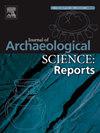连接罗马晚期和拜占庭早期:调查北希腊和保加利亚公元 6 世纪釉器的技术传统
IF 1.5
2区 历史学
0 ARCHAEOLOGY
引用次数: 0
摘要
我们使用 WD-XRF(器身分析)和 SEM-EDS(釉面分析)对在希腊塔索斯和保加利亚索菲亚的一个制陶作坊中发现的公元 6 世纪的釉器进行了研究。在这两种情况下,它们都与低钙质器身和高铅釉有关,铅化合物可能是在一次烧制前未添加二氧化硅而使用的。这种技术传统与迄今为止研究过的巴尔干半岛到意大利北部的第四至第五世纪晚期罗马釉器以及公元七世纪的 "拜占庭釉白器 I "都是相同的。因此,在釉面餐具在拜占庭后来得到显著发展之前,我们的文献可以被视为罗马晚期和拜占庭早期釉面餐具之间的 "缺失环节"。本文章由计算机程序翻译,如有差异,请以英文原文为准。
Connecting Late Roman and Early Byzantium: Investigating the technological tradition of 6th c. AD glazed wares from Northern Greece and Bulgaria
Glazed wares found in Thasos (Greece) and in a pottery workshop in Sofia (Bulgaria) in 6th c. AD contexts were investigated using WD-XRF (body analysis) and SEM-EDS (glaze analysis). In both cases, they associate low-calcareous bodies and high-lead glazes, with lead compounds probably applied without the addition of silica before a single firing. This technical tradition is common to the 4th−5th c. Late Roman glazed wares studied so far, from the Balkans to Northern Italy, and to the 7th c. AD “Byzantine Glazed White Ware I”. Our corpus may thus be seen as the “missing link” between the Late Roman and the Early Byzantine glazed wares, before glazed tableware meet with a remarkable development later on in Byzantium.
求助全文
通过发布文献求助,成功后即可免费获取论文全文。
去求助
来源期刊

Journal of Archaeological Science-Reports
ARCHAEOLOGY-
CiteScore
3.10
自引率
12.50%
发文量
405
期刊介绍:
Journal of Archaeological Science: Reports is aimed at archaeologists and scientists engaged with the application of scientific techniques and methodologies to all areas of archaeology. The journal focuses on the results of the application of scientific methods to archaeological problems and debates. It will provide a forum for reviews and scientific debate of issues in scientific archaeology and their impact in the wider subject. Journal of Archaeological Science: Reports will publish papers of excellent archaeological science, with regional or wider interest. This will include case studies, reviews and short papers where an established scientific technique sheds light on archaeological questions and debates.
 求助内容:
求助内容: 应助结果提醒方式:
应助结果提醒方式:


